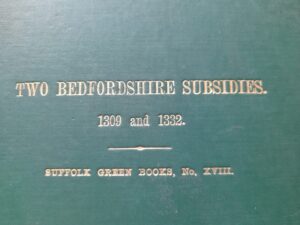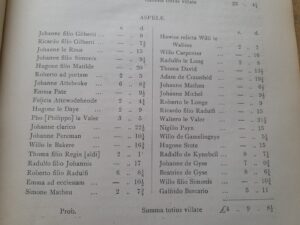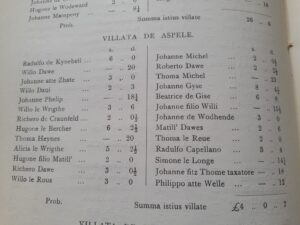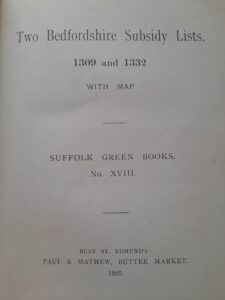1309 & 1332 Taxation in Aspley Guise
Published in 1925 by Sydenham Henry Augustus Hervey, Vol.18 of the Suffolk Green Book series gives the Subsidies taken in Bedfordshire in 1309 and 1332. A subsidy was the name for any taxation called for by the King in addition to what was usually collected. These had been taken as and when needed – to help pay for the Crusades, other wars or even to pay Royal ransoms!
What had to be paid depended on your wealth. Tax had to be paid on ‘moveables’ rather than land, so the value of a persons livestock or crops was used, on which a percentage had to be paid as tax. Usually 1/10th was called for, but sometimes it was as high as 1/4th or as low as 1/40th.

I have extracted the Aspley parts from both lists below. The first was taken in the third year of the reign of Edward II, when the rate was 1/25th and Bedfordshire collected £687 10s 3½d. in total for the King.
The second here was in the sixth year of the reign of Edward III, when a 1/15th was called for, from which collections from Bedfordshire contributed £615 13s 7¾d.
The names are as given in the original Latin document, the amounts they submitted and then my interpretation of their names. If anyone has a better grasp of Latin than mine (which wouldn’t be hard…) and can offer a better translation, please let me know!
1309 Aspele
Johanne filio Gilberti 9d. [John, son of Gilbert]
Ricardo filio Gilberti 7½d. [Richard, son of Gilbert]
Johanne le Rous 15d. [John the Red, Red-haired John?]]
Johane filio Simonis 9¼d. [John, son of Simon]
Hugone Filio Matilde 20d. [Hugo, son of Matilda]
Roberto ad portam 2s. 5d. [Robert at the Gate?]
Johanne Attebroke 6s. 8¾d. [John Attebroke]
Emma Pate 9½d. [Emma Pate]
Felicia Attewodehende 2s. 4¼d. [Felicity Attewodehende]
Hugone le Daye 2s. 9d. [Hugo Day]
Pho [Philippo] le Valer 3s. 5d. [Phillip who is worth?]
Johanne cleric 22½d. [John the Vicar? There is no record of who was vicar at this time]
Johanne Pereman 10¼d. [John Pereman]
Willo le Bakere 16¾d. [William the baker]
Thoma filio Regin [aldi] 2s. 1d. [Thomas, son of Reginald]
Radulfo filio Johannis 17d. [Randolf, son of John]
Roberto filio Radulfi 6s. 8¼d. [Robert, son of Randolf]
Emma ad ecclesiam 10½d. [Emma of the church]
Simone Matheu 2s. 7¾d. [Simon Mathew]
Hawise relicta Willi le Walisse 2s. 7d. [Hawis, widow of William the ???]
Willo Carpenter 16d. [William the carpenter]
Radulfo le Long 2s. 8d. [Randolf Long]
Thoma David 13½d. [Thomas David]
Adam de Craunfeld 19¼d. [Adam of Cranfield]
Johanne Matheu 6½d. [John Mathew]
Johanne Michel 9½d. [John Michael]
Roberto le Longe 9d. [Robert Long]
Ricardo filio Radulfi 15d. [Richard, son of Randolf]
Waltero le Valer 21¼d. [Walter who is worth?]
Nigillo Payn 15d. [Nigel Payne]
Willo de Gamelingeye 5¼d. [William of Gamlingay]
Hugone Stote 15d. [Hugo Stote]
Randulfo de Kynebell 8s. 7¼d. [Randolf of Kynebell]
Johanne de Gyse 7s. ¾d. [John of Gyse] the son of Anselm de Gyse
Beatrice de Gyse 8s. 6¼d. [Beatrice of Gyse] who was the widow of Anselm de Gyse
Willo filio Simonis 10¾d. [William, son of Simon]
Galfrido Bercario 5s. 11d. [Galfrido Bercario]
Summa totius villate: £4 9s. 8½d. [Total collected from this village]

1332 Villata de Aspele
Radulfo de Kynebell 6s. 0d. [Randolf of Kynebell]
Willo Dawe 20d. [William Dawe]
Johanne atte Zhate 3s. 0d. [John of ???]
Willo Daui 2s. 3d. [William Day]
Johanne Phelip 18¼d. [John Phillip]
Willo le Wrigthe 3s. 6d. [William the wheel(?)wright]
Richero de Craufeld 2s 0½d. [Richard of Cranfield]
Hugone le Bercher 6s. 2½d. [Hugo the shepherd]
Thoma Heynes 20d. [Thomas Heynes]
Alicia le Wrigthe 5s. 2½d. [Alicia the wheel(?)wright
Hugone filio Matill’ 2s. 0d. [Hugo, son of Matilda]
Richero Dawe 3s. 0½d. [Richard Dawe]
Willo le Rous 3s. 0d. [William the Red]
Johanne Michel 2s. 0½d. [John Michael]
Roberto Dawe 2s. 2½d. [Robert Dawe]
Thoma Michel 23d. [Thomas Michael]
Johanne Gyse 8s. 4½d. [John Gyse]
Beatrice de Gise 6s. 8d. [Beatrice of Gyse]
Johanne filio Willi 15½d. [John, son of William]
Johanne de Wodhende 3s. 0d. [John of Woodend]
Matill’ Dawes 2s. 6d. [Matilda Dawes]
Thoma le Reue 2s. 0d. [Thomas the ???]
Radulfo Capellano 5s. 4d. [Randolf Capellano]
Simone Le Longe 14¼d. [Simon Long]
Johanne fitz Thome taxatore 18d. [John, son of Thomas the taxman?]
Philippo atte Welle 12d. [Phillip Attwelle]
Summa istius villate £4 0s. 2d. [Total for this village]

You can see how these small amounts, being replicated across the whole country, soon added up to a significant sum for the King’s coffers.
The most interesting and easily researchable names here are the members of the de Gyse family. The two listed in both schedules above are a mother and son, as an Anselm de Gyse had married Beatrice de Crioll. That Anslem had died in c.1295, having had a son, John.
The original de Gyse family had come to England from France with William the Conqueror in 1066. According to the Gloucestershire Archives description of the family, the village of Aspley was owned by John de Burgh (son of Hubert, Earl of Kent) before 1267, he then subinfeudated [leased] it to Anselm de Gyse in that year. At the same time, de Burgh also transferred some lands in Elmore, Gloucestershire, to de Gyse.
There then followed at least eight generations of de Gyse who were involved with Aspley; five of which were named John, two were named Anselm and a Reginald. The de Gyse family added their own name to the little village in Bedfordshire (originally named after a clearing in the Aspen trees) in about 1375 and thus it became ‘Aspley Guise’.

After 300 years, it seems they decided to concentrate on their properties in Gloucestershire instead of Bedfordshire, as Anselme Gyes exchanged several properties with the Crown in December 1539, amongst which he gave up Aspley and received the manor of Brockworth in Gloucester instead. St Botolph’s Church, which dates from at least 1273, has a brass commemorating the Sir John de Guise who died in 1501.
The de Gyse family has continued, although the ‘de’ stopped being used in the late 1300s. One was knighted in 1619 and even though the Baronetcy they held became extinct in March 1783, it was revived the same year in a younger branch of the family. They have been M.P.’s and military Generals. Currently, Sir (Christopher) James Guise is the 8th Baronet of Highnam.
Page last updated February 2022.
